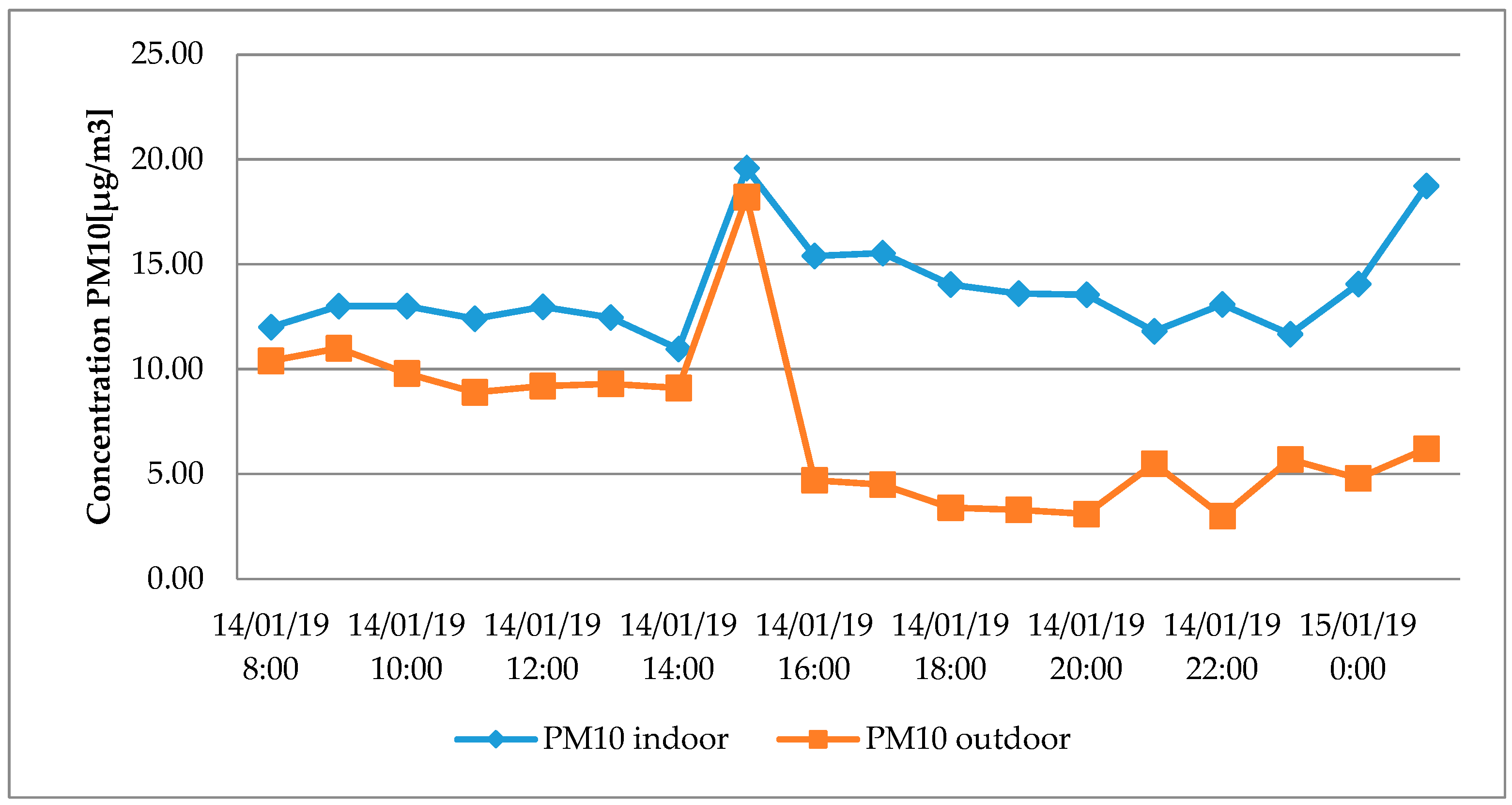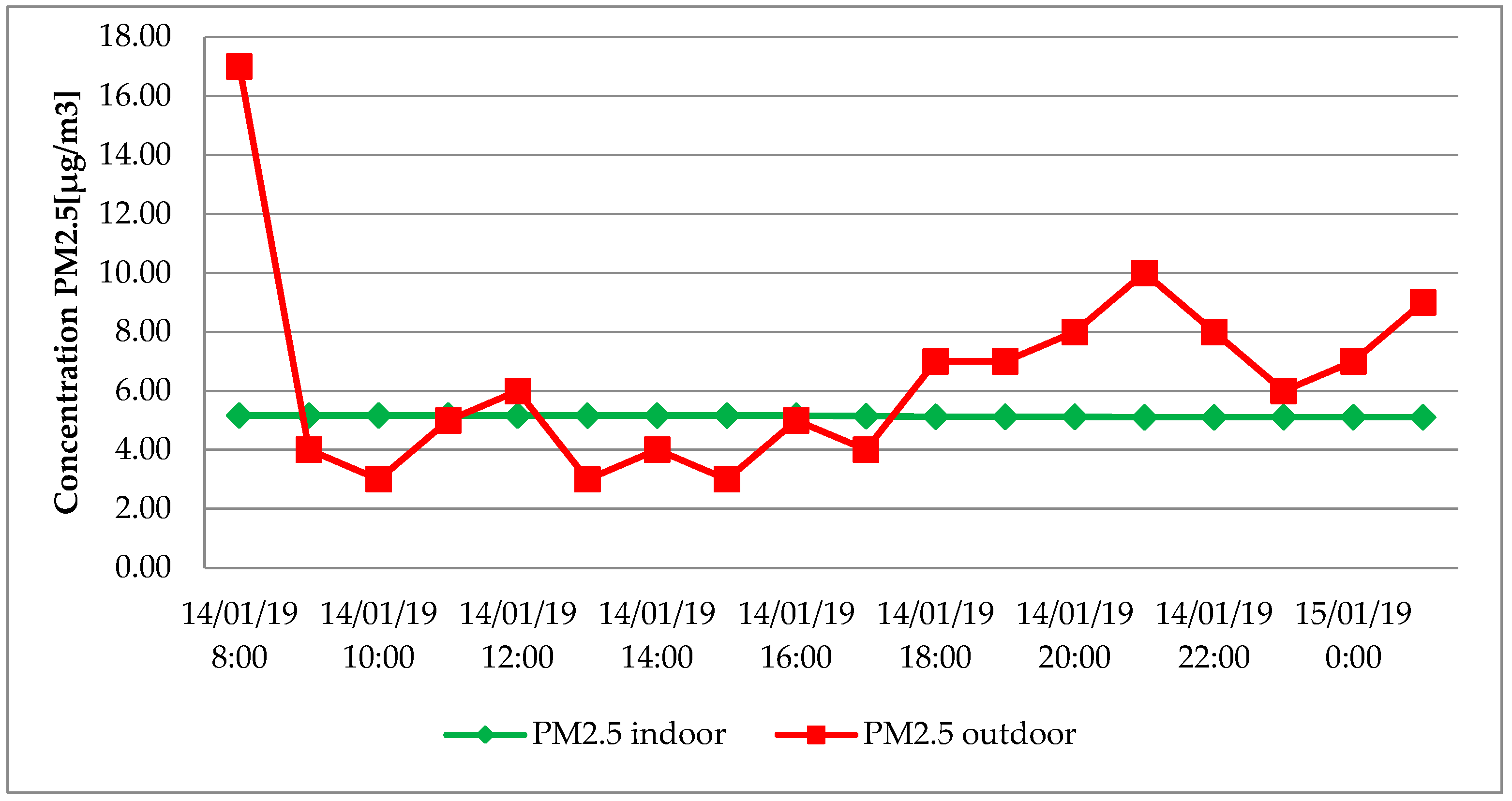Examination of PM10 and PM2.5 Concentration in an Apartment in a Multifamily Building †
Abstract
1. Introduction
2. Materials and Methods
- C(X,Y)—covariance between the characteristics of X and Y,
- Sx2—variance of the X trait,
- Sy2—variance of the Y trait,
- Sx—standard deviation of the X trait,
- Sy—standard deviation of the Y trait.
- |rXY| < 0.2—there is no linear relation between the features,
- 0.2 < |rXY| < 0.4—low (poor) linear relation,
- 0.4 < |rXY| < 0.7—moderate (average) correlation dependence,
- 0.7 < |rXY| < 0.9—significant (strong) linear relation,
- |rXY| > 0.9—very strong linear relation,
- |rXY| = 1.0—functional dependence (1—increasing linear function, −1—linear decreasing function),
- |rXY| = 0—lack of any dependence between features.
3. Results
4. Conclusions
Author Contributions
Acknowledgments
Conflicts of Interest
References
- Sulewska, M.; Gładyszewska-Fiedoruk, K. Analysis of the results of empirical research and surveys of perceived indoor temperature depending on gender and seasons. Environ. Sci. Pollut. Res. 2018, 25, 31205–31218. [Google Scholar] [CrossRef] [PubMed]
- Zabiegała, B. Jakość powietrza wewnętrznego—Lotne związki organiczne jako wskaźnik jakości powietrza wewnętrznego. Monografie Komitetu Inżynierii Środowiska 2009, 59, 303–315. [Google Scholar]
- Laska, M.; Dudkiewicz, E. Research of CO2 concentration in naturally ventilated lecture room. E3S Web Conf. 2017, 22, 00099. [Google Scholar] [CrossRef]
- Nantka, M.B. Wentylacja z Elementami Klimatyzacji; Wydawnictwo Politechniki Śląskiej: Gliwice, Poland, 2011. [Google Scholar]
- Teleszewski, T.; Gładyszewska-Fiedoruk, K. Changes of carbon dioxide concentrations in classrooms: Simplified model and experimental verification. Pol. J. Enviro. Stud. 2018, 27, 2397–2403. [Google Scholar] [CrossRef] [PubMed]
- Gładyszewska-Fiedoruk, K.; Nieciecki, M. Indoor Air Quality in a Multi–car Garage. Energy Procedia 2016, 95, 132–139. [Google Scholar] [CrossRef]
- Asikainen, A.; Carrer, P.; Kephalopoulos, S.; de Oliveira Fernandes, E.; Wargocki, P.; Hänninen, O. Reducing burden of disease from residential indoor air exposures in Europe (HEALTHVENT project). Environ. Health 2016, 15, 61–72. [Google Scholar] [CrossRef] [PubMed]
- Asikainen, A.; Hänninen, O. Efficient Reduction of Indoor Exposures—Health Benefits from Optimizing Ventilation, Filtration and Indoor Source Controls. Report 2/2013 (National Institute of Health and Welfare, Tampere, 2013). Available online: http://www.julkari.fi/handle/10024/110211 (accessed on 8 February 2019).
- Wijayatunga, P. A geometric view on Pearson’s correlation coefficient and a generalization of it to non-linear dependencies. Ratio Math. 2016, 30, 3–21. [Google Scholar]
- WHO. Air Quality Guidelines for Particulate Matter, Ozone, Nitrogen Dioxide and Sulfur Dioxide. Summary of Risk Assessment. Available online: http://www.euro.who.int/en/health-topics/environment-and-health/air-quality/publications/pre2009/air-quality-guidelines.-global-update-2005.-particulate-matter,-ozone,-nitrogen-dioxide-and-sulfur-dioxide (accessed on 1 February 2019).


Disclaimer/Publisher’s Note: The statements, opinions and data contained in all publications are solely those of the individual author(s) and contributor(s) and not of MDPI and/or the editor(s). MDPI and/or the editor(s) disclaim responsibility for any injury to people or property resulting from any ideas, methods, instructions or products referred to in the content. |
© 2019 by the author. Licensee MDPI, Basel, Switzerland. This article is an open access article distributed under the terms and conditions of the Creative Commons Attribution (CC BY) license (https://creativecommons.org/licenses/by/4.0/).
Share and Cite
Wysocka, M. Examination of PM10 and PM2.5 Concentration in an Apartment in a Multifamily Building. Proceedings 2019, 16, 49. https://doi.org/10.3390/proceedings2019016049
Wysocka M. Examination of PM10 and PM2.5 Concentration in an Apartment in a Multifamily Building. Proceedings. 2019; 16(1):49. https://doi.org/10.3390/proceedings2019016049
Chicago/Turabian StyleWysocka, Monika. 2019. "Examination of PM10 and PM2.5 Concentration in an Apartment in a Multifamily Building" Proceedings 16, no. 1: 49. https://doi.org/10.3390/proceedings2019016049
APA StyleWysocka, M. (2019). Examination of PM10 and PM2.5 Concentration in an Apartment in a Multifamily Building. Proceedings, 16(1), 49. https://doi.org/10.3390/proceedings2019016049



